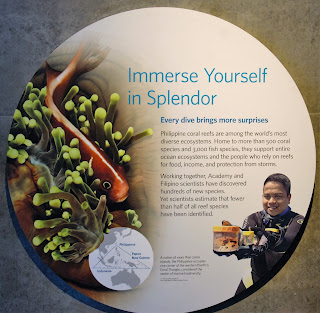Our 'diving site' was a 212,000-gallon aquarium of the California Academy of Sciences (CAS), which replicates some of the diversity found in our coral reefs.
The coral reefs, says CAS, 'are among the world's most diverse ecosystems. Home to more than 500 coral species and 3,000 fish species of fish, they support entire ocean ecosystems and the people rely on reefs for food, income, and protection from storms.'
The Academy has been doing research in our country for more than a century, and the latest one was the 2014 Philippine Biodiversity Expedition that focused on marine habitats near the apex of the Coral Triangle. It surveyed the Triangle's 'twilight zone', a habitat 40 to 150 meters deep, where no humans had entered before.
The Academy has been doing research in our country for more than a century, and the latest one was the 2014 Philippine Biodiversity Expedition that focused on marine habitats near the apex of the Coral Triangle. It surveyed the Triangle's 'twilight zone', a habitat 40 to 150 meters deep, where no humans had entered before.
The Triangle refers to the triangular area of the marine waters of Indonesia, Malaysia, Papua New Guinea, Philippines, Solomon Islands and Timor-Leste. The Philippines is near its apex.
Hundreds of species have been discovered through the joint efforts of Academy and Filipino scientists but they estimate that 'fewer than half of all reef species have been identified.' During the cited expedition, at least 300 new species were discovered' such as the deep-water coral Philippine sea fan (Solenocaulon sp.) and the spiny, globular Philippine pencil urchin (Phyllacanthus imperialis), whose specimens are on display at the CAS.
The Academy noted that pollution, coastal development, global climate change, and non-sustainable fishing practices pose severe threats to Philippine diversity. It has 'developed a practice of rapidly translating data collected in the field into effective marine conservation actions.'
'The 2011 Philippine Expedition,' the Academy reported in its webpage, 'resulted in recommendations for better regulation of existing Marine Protected Areas, as well as the establishment of new MPAs. Today, that work—in conjunction with community-based conversation projects—has recently begun to yield reversed degradation in coral reefs. While the threats still far outweigh any recovery, these comprehensive policies and practices have begun to slow the loss of biodiversity in the Philippines. Here [in California], our work in the Philippines enriches and informs Academy exhibits, where it continues to reach millions of visitors, teachers, and students each year.'
Part of the exhibit is a video presentation of 'Filipino Voices' which shows Filipinos 'who are championing marine sanctuaries, changing fishing practices, protecting precious reefs for future generations.'
In its caption on the Philippine pencil urchin, the Academy cited the villagers living near Batalang Bato, a popular dive spot. 'After decades of unsustainable practices,' CAS said, '[they] established one of the first community-initiated marine sanctuaries. Academy researchers worked closely with the community leaders and after six years of protection, a once depleted reef now teems with life that will repopulate other nearby reefs.'
This community action resonates with the marine turtles conservation project of volunteer fisher folks in our coastal village La Paz in the San Narciso town of Zambales province. For the past four years, they have been operating a hatchery during the nesting season to ensure the survival of the endangered Olive ridley turtles for future generations. They know that these creatures feed on sea grass and in so doing, they maintain the balance in the ecosystems in the reefs, the breeding ground of fishes. Fishing is the primary source of livelihood of these volunteers.




























